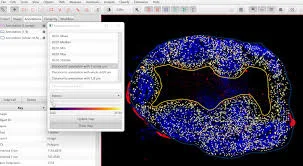Spatial analysis has become an essential component of modern histology and pathology, enabling researchers to extract meaningful insights from complex tissue architectures. One significant aspect of this analysis is the measurement of cell-to-cell distance, which can reveal critical information about cellular interactions, tissue microenvironments, and disease states. In this article, we will explore spatial analysis in QuPath, focusing specifically on the concept of cell-to-cell distance, its importance, and how it can be effectively measured and interpreted.
What is QuPath?
Overview of QuPath
QuPath is an open-source software platform designed for digital pathology and whole-slide image analysis. It offers powerful tools for annotating images, detecting features, and performing quantitative analysis. Researchers and pathologists use QuPath to streamline workflows and gain insights into tissue samples, making it an invaluable resource in biomedical research.
Key Features
QuPath provides a range of features, including:
- Image Annotation: Users can annotate regions of interest within whole-slide images.
- Machine Learning: The platform supports the application of machine learning algorithms for automated analysis.
- Quantitative Measurements: QuPath allows users to perform various quantitative measurements, including cell density, area, and distance metrics.
Understanding Cell-to-Cell Distance
What is Cell-to-Cell Distance?
Cell-to-cell distance refers to the spatial measurement between the centroids of individual cells within a tissue section. This metric can provide insights into cellular interactions, such as signaling pathways, immune responses, and tumor microenvironments.
Importance of Measuring Cell-to-Cell Distance
Understanding the spatial relationships between cells is crucial for several reasons:
- Cellular Interactions: Close proximity between cells can indicate potential signaling or communication, while greater distances might suggest isolation or less interaction.
- Disease Insights: Abnormal cell spacing can be indicative of pathological conditions, such as tumors where cell density and distance might influence tumor progression and metastasis.
- Microenvironmental Analysis: Analyzing distances in immune cells within tumors can reveal how the immune landscape affects cancer progression.
Performing Spatial Analysis in QuPath
Step-by-Step Guide
To measure cell-to-cell distance in QuPath, follow these steps:
- Load the Whole-Slide Image: Begin by importing your whole-slide image into QuPath.
- Cell Detection: Utilize QuPath’s cell detection algorithms to identify individual cells within the tissue. This can be done using predefined parameters for cell size, shape, and intensity.
- Annotation: Annotate the areas of interest where you wish to measure cell-to-cell distances.
- Distance Measurement: Use the built-in measurement tools to calculate the distances between the centroids of detected cells. QuPath allows for various statistical analyses, enabling users to generate distance matrices.
- Export Data: After measuring, export the data for further analysis in statistical software or for visualization.
Statistical Analysis
Once the distances are measured, performing statistical analysis is crucial. Common metrics include:
- Mean Distance: Average distance between all pairs of cells.
- Median Distance: The middle value when distances are sorted, providing insight into the distribution.
- Distance Distribution: Understanding how distances are distributed can reveal patterns of cellular organization.
Case Studies and Applications
Tumor Microenvironment Studies
Research has shown that spatial analysis of cell-to-cell distances can significantly impact our understanding of tumor microenvironments. A study published in Nature Reviews Cancer highlighted that closer distances between tumor cells and immune cells could indicate an active immune response, while greater distances might suggest immune evasion (Fridman et al., 2017).
Immune Cell Interactions
Another study demonstrated the importance of cell-to-cell distance in immune interactions. Researchers found that lymphocyte distance from cancer cells influenced therapeutic outcomes in breast cancer, emphasizing that effective immune responses are often correlated with reduced distances between immune cells and tumor cells (Gajewski et al., 2013).
Challenges in Measuring Cell-to-Cell Distance
Variability in Cell Size and Shape
One challenge in spatial analysis is the variability in cell size and shape, which can impact distance measurements. Irregularly shaped cells may present difficulties in defining precise centroids, potentially leading to inaccuracies.
Sample Preparation and Artifacts
Tissue processing and sectioning can introduce artifacts that affect measurements. Ensuring high-quality preparation and imaging is critical for obtaining reliable data.
Software Limitations
While QuPath is a powerful tool, it is essential to be aware of its limitations, including processing speed with very large images and the potential need for user-defined adjustments in detection parameters.

Conclusion
In summary, spatial analysis in QuPath, particularly the measurement of cell-to-cell distance, offers valuable insights into cellular interactions and microenvironments. Understanding these distances can illuminate critical aspects of disease pathology and treatment responses. As research continues to advance, tools like QuPath will be instrumental in deepening our understanding of tissue architecture and cellular behavior. Are you ready to explore the spatial relationships within your tissue samples using QuPath?










